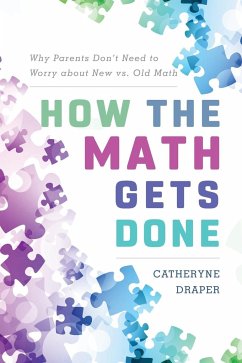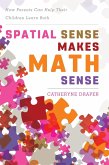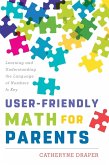- Gebundenes Buch
- Merkliste
- Auf die Merkliste
- Bewerten Bewerten
- Teilen
- Produkt teilen
- Produkterinnerung
- Produkterinnerung
How the Math Gets Done: Why Parents Don't Need to Worry About New vs. Old Math provides a roadmap to understanding what the symbols for math operations (add, subtract, multiply, and divide) really mean, what the clues are to interpret these symbols, and a kind of short story of how they evolved over time.
Andere Kunden interessierten sich auch für
![The Self-Organizing School The Self-Organizing School]() Alan BainThe Self-Organizing School98,99 €
Alan BainThe Self-Organizing School98,99 €![The Malfunction of US Education Policy The Malfunction of US Education Policy]() Richard P. PhelpsThe Malfunction of US Education Policy71,99 €
Richard P. PhelpsThe Malfunction of US Education Policy71,99 €![The Kids are Smart Enough, So What's the Problem? The Kids are Smart Enough, So What's the Problem?]() Richard W. GarrettThe Kids are Smart Enough, So What's the Problem?44,99 €
Richard W. GarrettThe Kids are Smart Enough, So What's the Problem?44,99 €![Everyday Steam for the Early Childhood Classroom Everyday Steam for the Early Childhood Classroom]() Margaret Loring MerrillEveryday Steam for the Early Childhood Classroom160,99 €
Margaret Loring MerrillEveryday Steam for the Early Childhood Classroom160,99 €![Spatial Sense Makes Math Sense Spatial Sense Makes Math Sense]() Catheryne DraperSpatial Sense Makes Math Sense93,99 €
Catheryne DraperSpatial Sense Makes Math Sense93,99 €![User-Friendly Math for Parents User-Friendly Math for Parents]() Catheryne DraperUser-Friendly Math for Parents49,99 €
Catheryne DraperUser-Friendly Math for Parents49,99 €![User-Friendly Math for Parents User-Friendly Math for Parents]() Catheryne DraperUser-Friendly Math for Parents94,99 €
Catheryne DraperUser-Friendly Math for Parents94,99 €-
-
-
How the Math Gets Done: Why Parents Don't Need to Worry About New vs. Old Math provides a roadmap to understanding what the symbols for math operations (add, subtract, multiply, and divide) really mean, what the clues are to interpret these symbols, and a kind of short story of how they evolved over time.
Hinweis: Dieser Artikel kann nur an eine deutsche Lieferadresse ausgeliefert werden.
Hinweis: Dieser Artikel kann nur an eine deutsche Lieferadresse ausgeliefert werden.
Produktdetails
- Produktdetails
- Verlag: Rowman & Littlefield Publishers
- Seitenzahl: 160
- Erscheinungstermin: 25. Oktober 2017
- Englisch
- Abmessung: 260mm x 183mm x 13mm
- Gewicht: 509g
- ISBN-13: 9781475834222
- ISBN-10: 1475834225
- Artikelnr.: 48695645
- Herstellerkennzeichnung
- Libri GmbH
- Europaallee 1
- 36244 Bad Hersfeld
- gpsr@libri.de
- Verlag: Rowman & Littlefield Publishers
- Seitenzahl: 160
- Erscheinungstermin: 25. Oktober 2017
- Englisch
- Abmessung: 260mm x 183mm x 13mm
- Gewicht: 509g
- ISBN-13: 9781475834222
- ISBN-10: 1475834225
- Artikelnr.: 48695645
- Herstellerkennzeichnung
- Libri GmbH
- Europaallee 1
- 36244 Bad Hersfeld
- gpsr@libri.de
By Catheryne Draper
Foreword Preface Introduction Part I. Definition 1. Math According to Jen,
Bobby, and Others Jen's Deductions Bobby's Experience with Multiplication
and Number Arrangements Children's Descriptions About Making Sense Trevor
and Jim Invent Their Own Multiplication Methods Keep in Mind 2. Math
Grammar of Nouns, Verbs, and Stories "Putting Together" Verbs for Addition
and Multiplication "Taking Apart" Verbs for Subtraction and Division A
Short Interlude About the Use of that Negative Sign Word Problems Put Math
Verbs in Stories Keep in Mind 3. A Choice between Two Rs - Rote
Memorization or Reasoning Sound Bites That Bite Back Memorization vs.
Organization Acronyms - Sense or Nonsense Keep in Mind Part II.
Organization 4. In Search of Like Terms, Classification Revisited Like
Terms, Common Denominators, and Same Units Place Value Columns Have Like
Terms Categories What's Wrong with this Picture? Adding Percentages A Note
About Multiplication and Division Keep in Mind 5. Artful Assembly of
Operations Facts, Frogs, and Formats Jackie's Thinking About Number
Operations James, Janie, and Napier's Lattice Multiplication Division
Interpretations That Made Sense Keep in Mind 6. Same Math, Same Meaning,
Different Organization - New vs. Old "If It Ain't Broke, Don't Fix It."
Multiplication Organization Sense Digit Alignment Continues Zeke, Jake, and
Long Division Keep in Mind Part III. Relationships and Patterns 7. "Seeing"
Math Patterns with Viewfinders Multiplication Table Patterns Addition Table
Patterns Kathy's and Rudy's Fraction Viewfinders Keep in Mind 8. Spelunking
for Patterns with More Viewfinders Reflections on Addition and
Multiplication Subtraction, Division, and Missy's "Different Family" A Few
Rules of Engagement for Working with Numbers Keep in Mind 9. Functions,
Predictability, and Balance Predictability and Functions One Answer or Many
Answers, Same Balance Keep in Mind Part IV. Connections 10. A
Multiplication Area Image for the Ages From Theon to Dienes - A Bridge
Across the Centuries Same Design for Mixed Numbers, Fractions and Decimals
Visual-Spatial Multi-Digit Multiplication Keep in Mind 11. Ratios,
Proportions, and Rate of Change Fractions as Gatekeepers David's
Decluttering Fractions Changing Numbers, Changing Locations, and Moving
Targets in Proportions Slope as a Rate of Change Keep in Mind 12. Algebraic
Thinking The Shapes for an Algebra Transition From Multiplication Tables to
Coordinate Tables Jill's Graphic Solutions F.O.I.L.'ed Again Keep in Mind
Conclusion: What Parents Can Do Problem Solving Beyond Word Problems Right
Tool for the Right Job - A Hard Look At Technology Keep in Mind Glossary
References About the Author
Bobby, and Others Jen's Deductions Bobby's Experience with Multiplication
and Number Arrangements Children's Descriptions About Making Sense Trevor
and Jim Invent Their Own Multiplication Methods Keep in Mind 2. Math
Grammar of Nouns, Verbs, and Stories "Putting Together" Verbs for Addition
and Multiplication "Taking Apart" Verbs for Subtraction and Division A
Short Interlude About the Use of that Negative Sign Word Problems Put Math
Verbs in Stories Keep in Mind 3. A Choice between Two Rs - Rote
Memorization or Reasoning Sound Bites That Bite Back Memorization vs.
Organization Acronyms - Sense or Nonsense Keep in Mind Part II.
Organization 4. In Search of Like Terms, Classification Revisited Like
Terms, Common Denominators, and Same Units Place Value Columns Have Like
Terms Categories What's Wrong with this Picture? Adding Percentages A Note
About Multiplication and Division Keep in Mind 5. Artful Assembly of
Operations Facts, Frogs, and Formats Jackie's Thinking About Number
Operations James, Janie, and Napier's Lattice Multiplication Division
Interpretations That Made Sense Keep in Mind 6. Same Math, Same Meaning,
Different Organization - New vs. Old "If It Ain't Broke, Don't Fix It."
Multiplication Organization Sense Digit Alignment Continues Zeke, Jake, and
Long Division Keep in Mind Part III. Relationships and Patterns 7. "Seeing"
Math Patterns with Viewfinders Multiplication Table Patterns Addition Table
Patterns Kathy's and Rudy's Fraction Viewfinders Keep in Mind 8. Spelunking
for Patterns with More Viewfinders Reflections on Addition and
Multiplication Subtraction, Division, and Missy's "Different Family" A Few
Rules of Engagement for Working with Numbers Keep in Mind 9. Functions,
Predictability, and Balance Predictability and Functions One Answer or Many
Answers, Same Balance Keep in Mind Part IV. Connections 10. A
Multiplication Area Image for the Ages From Theon to Dienes - A Bridge
Across the Centuries Same Design for Mixed Numbers, Fractions and Decimals
Visual-Spatial Multi-Digit Multiplication Keep in Mind 11. Ratios,
Proportions, and Rate of Change Fractions as Gatekeepers David's
Decluttering Fractions Changing Numbers, Changing Locations, and Moving
Targets in Proportions Slope as a Rate of Change Keep in Mind 12. Algebraic
Thinking The Shapes for an Algebra Transition From Multiplication Tables to
Coordinate Tables Jill's Graphic Solutions F.O.I.L.'ed Again Keep in Mind
Conclusion: What Parents Can Do Problem Solving Beyond Word Problems Right
Tool for the Right Job - A Hard Look At Technology Keep in Mind Glossary
References About the Author
Foreword Preface Introduction Part I. Definition 1. Math According to Jen,
Bobby, and Others Jen's Deductions Bobby's Experience with Multiplication
and Number Arrangements Children's Descriptions About Making Sense Trevor
and Jim Invent Their Own Multiplication Methods Keep in Mind 2. Math
Grammar of Nouns, Verbs, and Stories "Putting Together" Verbs for Addition
and Multiplication "Taking Apart" Verbs for Subtraction and Division A
Short Interlude About the Use of that Negative Sign Word Problems Put Math
Verbs in Stories Keep in Mind 3. A Choice between Two Rs - Rote
Memorization or Reasoning Sound Bites That Bite Back Memorization vs.
Organization Acronyms - Sense or Nonsense Keep in Mind Part II.
Organization 4. In Search of Like Terms, Classification Revisited Like
Terms, Common Denominators, and Same Units Place Value Columns Have Like
Terms Categories What's Wrong with this Picture? Adding Percentages A Note
About Multiplication and Division Keep in Mind 5. Artful Assembly of
Operations Facts, Frogs, and Formats Jackie's Thinking About Number
Operations James, Janie, and Napier's Lattice Multiplication Division
Interpretations That Made Sense Keep in Mind 6. Same Math, Same Meaning,
Different Organization - New vs. Old "If It Ain't Broke, Don't Fix It."
Multiplication Organization Sense Digit Alignment Continues Zeke, Jake, and
Long Division Keep in Mind Part III. Relationships and Patterns 7. "Seeing"
Math Patterns with Viewfinders Multiplication Table Patterns Addition Table
Patterns Kathy's and Rudy's Fraction Viewfinders Keep in Mind 8. Spelunking
for Patterns with More Viewfinders Reflections on Addition and
Multiplication Subtraction, Division, and Missy's "Different Family" A Few
Rules of Engagement for Working with Numbers Keep in Mind 9. Functions,
Predictability, and Balance Predictability and Functions One Answer or Many
Answers, Same Balance Keep in Mind Part IV. Connections 10. A
Multiplication Area Image for the Ages From Theon to Dienes - A Bridge
Across the Centuries Same Design for Mixed Numbers, Fractions and Decimals
Visual-Spatial Multi-Digit Multiplication Keep in Mind 11. Ratios,
Proportions, and Rate of Change Fractions as Gatekeepers David's
Decluttering Fractions Changing Numbers, Changing Locations, and Moving
Targets in Proportions Slope as a Rate of Change Keep in Mind 12. Algebraic
Thinking The Shapes for an Algebra Transition From Multiplication Tables to
Coordinate Tables Jill's Graphic Solutions F.O.I.L.'ed Again Keep in Mind
Conclusion: What Parents Can Do Problem Solving Beyond Word Problems Right
Tool for the Right Job - A Hard Look At Technology Keep in Mind Glossary
References About the Author
Bobby, and Others Jen's Deductions Bobby's Experience with Multiplication
and Number Arrangements Children's Descriptions About Making Sense Trevor
and Jim Invent Their Own Multiplication Methods Keep in Mind 2. Math
Grammar of Nouns, Verbs, and Stories "Putting Together" Verbs for Addition
and Multiplication "Taking Apart" Verbs for Subtraction and Division A
Short Interlude About the Use of that Negative Sign Word Problems Put Math
Verbs in Stories Keep in Mind 3. A Choice between Two Rs - Rote
Memorization or Reasoning Sound Bites That Bite Back Memorization vs.
Organization Acronyms - Sense or Nonsense Keep in Mind Part II.
Organization 4. In Search of Like Terms, Classification Revisited Like
Terms, Common Denominators, and Same Units Place Value Columns Have Like
Terms Categories What's Wrong with this Picture? Adding Percentages A Note
About Multiplication and Division Keep in Mind 5. Artful Assembly of
Operations Facts, Frogs, and Formats Jackie's Thinking About Number
Operations James, Janie, and Napier's Lattice Multiplication Division
Interpretations That Made Sense Keep in Mind 6. Same Math, Same Meaning,
Different Organization - New vs. Old "If It Ain't Broke, Don't Fix It."
Multiplication Organization Sense Digit Alignment Continues Zeke, Jake, and
Long Division Keep in Mind Part III. Relationships and Patterns 7. "Seeing"
Math Patterns with Viewfinders Multiplication Table Patterns Addition Table
Patterns Kathy's and Rudy's Fraction Viewfinders Keep in Mind 8. Spelunking
for Patterns with More Viewfinders Reflections on Addition and
Multiplication Subtraction, Division, and Missy's "Different Family" A Few
Rules of Engagement for Working with Numbers Keep in Mind 9. Functions,
Predictability, and Balance Predictability and Functions One Answer or Many
Answers, Same Balance Keep in Mind Part IV. Connections 10. A
Multiplication Area Image for the Ages From Theon to Dienes - A Bridge
Across the Centuries Same Design for Mixed Numbers, Fractions and Decimals
Visual-Spatial Multi-Digit Multiplication Keep in Mind 11. Ratios,
Proportions, and Rate of Change Fractions as Gatekeepers David's
Decluttering Fractions Changing Numbers, Changing Locations, and Moving
Targets in Proportions Slope as a Rate of Change Keep in Mind 12. Algebraic
Thinking The Shapes for an Algebra Transition From Multiplication Tables to
Coordinate Tables Jill's Graphic Solutions F.O.I.L.'ed Again Keep in Mind
Conclusion: What Parents Can Do Problem Solving Beyond Word Problems Right
Tool for the Right Job - A Hard Look At Technology Keep in Mind Glossary
References About the Author








